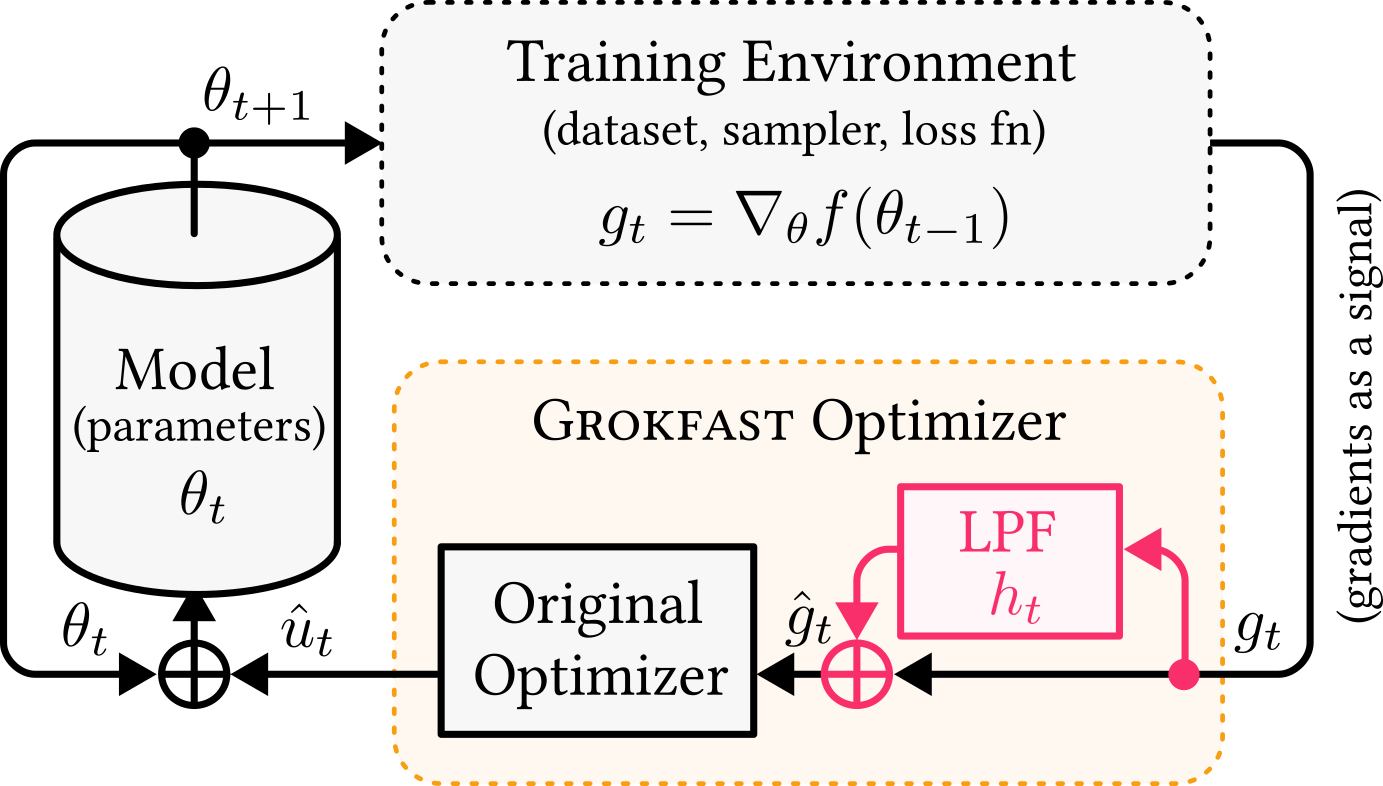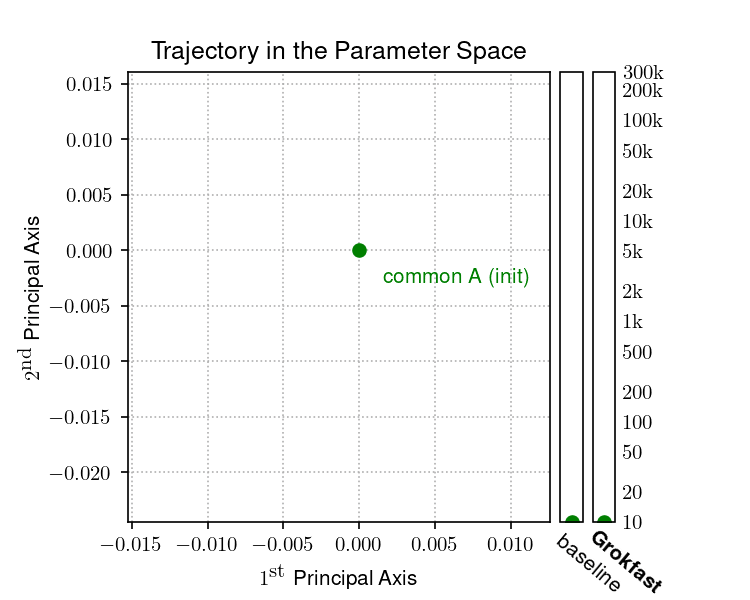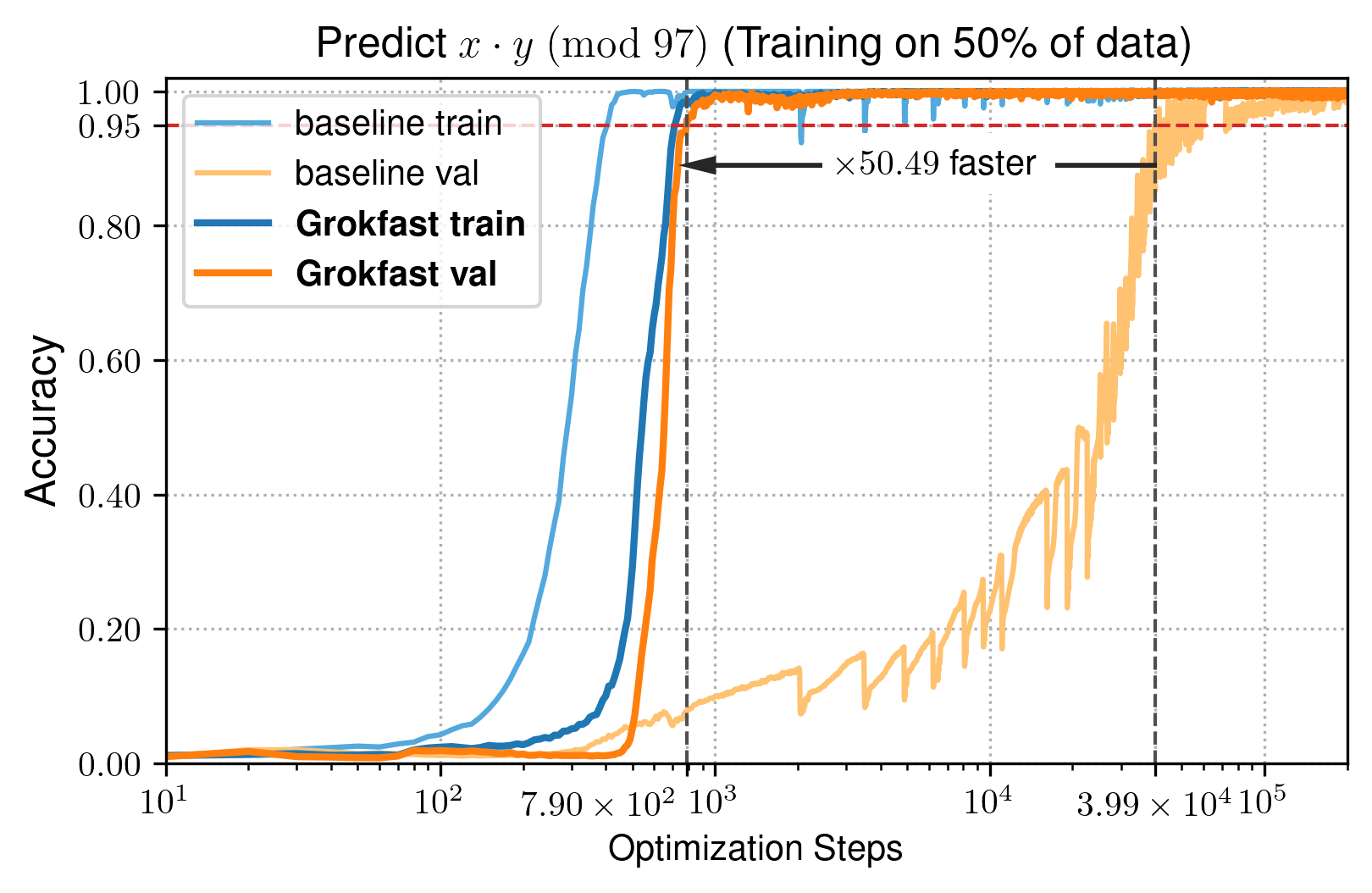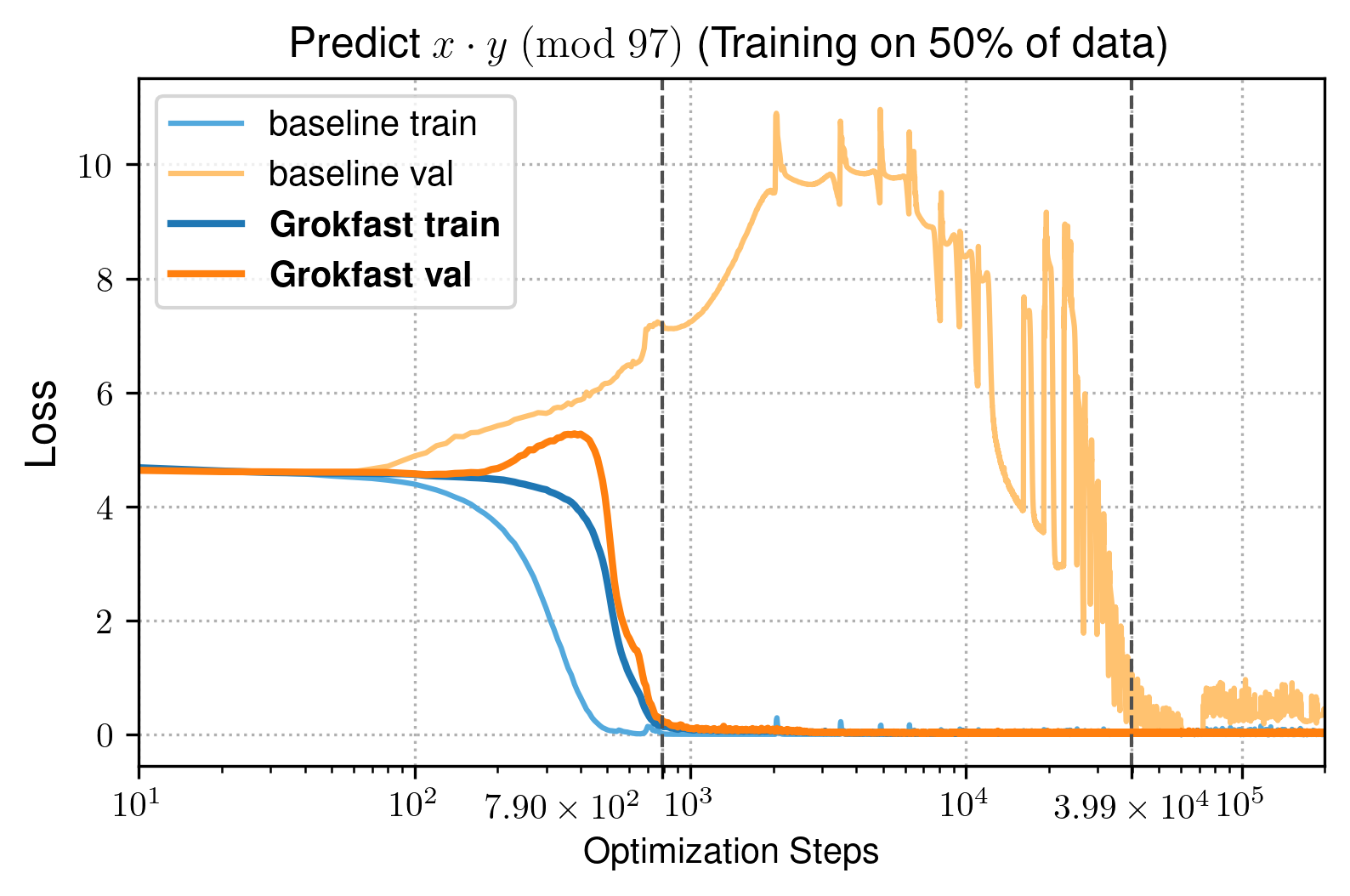Grokfast: 通过放大缓慢梯度
加速Grokking过程
Jaerin Lee* · Bong Gyun Kang* · Kihoon Kim · Kyoung Mu Lee
首尔国立大学
*表示贡献相同。
简述: 我们通过使用增强优化器放大参数梯度的低频分量来加速grokking现象。
 |  |
|---|
摘要: 机器学习中一个令人困惑的现象被称为grokking,即在几乎完美地过拟合训练数据后,模型在数十倍的迭代次数后才实现延迟泛化。 从机器学习实践者的角度出发,我们的目标是加速grokking现象下模型的泛化过程。 通过将参数在训练迭代过程中的一系列梯度视为时间上的随机信号,我们可以将梯度下降下的参数轨迹在频谱上分解为两个部分:快速变化的、导致过拟合的部分和缓慢变化的、引导泛化的部分。 这种分析使我们能够通过仅仅几行代码来放大梯度的缓慢变化部分,从而将grokking现象加速50倍以上。 实验表明,我们的算法适用于涉及图像、语言和图形的各种任务,使这种突然泛化的特殊现象在实践中变得可用。
 |  |
|---|
使用方法
安装
Grokfast除了PyTorch外不需要额外的包。文件requirements.txt仅用于复现文章中的实验,如下面的复现部分所述。
说明
Grokfast可以通过在优化器调用前插入一行代码来应用。
- 从我们的仓库下载单个文件
grokfast.py。
wget https://raw.githubusercontent.com/ironjr/grokfast/main/grokfast.py
- 导入辅助函数。
from grokfast import gradfilter_ma, gradfilter_ema
- 在训练循环之前插入以下行。
grads = None
- 在
loss.backward()和optimizer.step()之间插入以下行之一。确保model的类型为nn.Module,并且grads在训练循环前正确初始化:
# ... 在优化循环中。
loss.backwards() # 计算梯度。
### 选项1:Grokfast(有参数alpha、lamb)
grads = gradfilter_ema(model, grads=grads, alpha=alpha, lamb=lamb)
### 选项2:Grokfast-MA(有参数window_size、lamb)
# grads = gradfilter_ma(model, grads=grads, window_size=window_size, lamb=lamb)
optimizer.step() # 调用优化器。
# ... 日志记录和其他代码。
完成!
(2-1) ...或者,直接将方法复制粘贴到你的代码中!
### 导入
from collections import deque
from typing import Dict, Optional, Literal
import torch
import torch.nn as nn
### Grokfast
def gradfilter_ema(
m: nn.Module,
grads: Optional[Dict[str, torch.Tensor]] = None,
alpha: float = 0.99,
lamb: float = 5.0,
) -> Dict[str, torch.Tensor]:
if grads is None:
grads = {n: p.grad.data.detach() for n, p in m.named_parameters() if p.requires_grad}
for n, p in m.named_parameters():
if p.requires_grad:
grads[n] = grads[n] * alpha + p.grad.data.detach() * (1 - alpha)
p.grad.data = p.grad.data + grads[n] * lamb
return grads
### Grokfast-MA
def gradfilter_ma(
m: nn.Module,
grads: Optional[Dict[str, deque]] = None,
window_size: int = 128,
lamb: float = 5.0,
filter_type: Literal['mean', 'sum'] = 'mean',
warmup: bool = True,
trigger: bool = False,
) -> Dict[str, deque]:
if grads is None:
grads = {n: deque(maxlen=window_size) for n, p in m.named_parameters() if p.requires_grad}
for n, p in m.named_parameters():
if p.requires_grad:
grads[n].append(p.grad.data.detach())
if not warmup or len(grads[n]) == window_size and not trigger:
if filter_type == "mean":
avg = sum(grads[n]) / len(grads[n])
elif filter_type == "sum":
avg = sum(grads[n])
else:
raise ValueError(f"无法识别的filter_type {filter_type}")
p.grad.data = p.grad.data + avg * lamb
return grads
参数
-
Grokfast (
gradfilter_ema)m: nn.Module: 包含所有可训练参数的模型。grads: Optional[Dict[str, torch.Tensor]] = None: 运行中的内存(EMA)。通过设置为None进行初始化。之后递归地输入该方法的输出。alpha: float = 0.98: EMA的动量超参数。lamb: float = 2.0: 滤波器的放大因子超参数。
-
Grokfast-MA (
gradfilter_ma)m: nn.Module: 包含所有可训练参数的模型。grads: Optional[Dict[str, deque]] = None: 运行中的内存(用于窗口移动平均的队列)。通过设置为None进行初始化。之后递归地输入该方法的输出。window_size: int = 100: 滤波器窗口的宽度。额外的内存需求随窗口大小线性增加。lamb: float = 5.0: 滤波器的放大因子超参数。filter_type: Literal['mean', 'sum'] = 'mean': 运行队列的聚合方法。warmup: bool = True: 如果为真,则在队列填满之前不应用滤波器。trigger: bool = False: 仅用于消融研究。如果为真,则不应用滤波器。
复现
我们还注意到每次运行所需的额外计算资源。时间和内存成本是在单个GTX 1080 Ti GPU上测量的。
安装
这将安装额外的包来预处理每个数据并总结结果。
conda create -n grok python=3.10 && conda activate grok
git clone https://github.com/ironjr/grokfast
pip install -r requirements.txt
算法数据(Transformer解码器,Grokfast-MA)
| 运行 | 达到95%验证准确率的迭代次数 | 达到95%验证准确率的壁钟时间(秒) | VRAM需求(MB) | 每次迭代的延迟(秒) |
|---|---|---|---|---|
| 基线 | 39890 | 5984 | 290 | 0.15 |
| Grokfast-MA | 790($\times$ 50.49 $\downarrow$) | 292($\times$ 20.49 $\downarrow$) | 458 | 0.37 |
# python main.py --label test # 基线。
python main.py --label test --filter ma --window_size 100 --lamb 5.0 --weight_decay 0.01
算法数据(Transformer解码器,Grokfast)
| 运行 | 达到95%验证准确率的迭代次数 | 达到95%验证准确率的壁钟时间(秒) | VRAM需求(MB) | 每次迭代的延迟(秒) |
|---|---|---|---|---|
| 基线 | 39890 | 5984 | $290 | 0.15 |
| Grokfast | 910($\times$ 43.84 $\downarrow$) | 137($\times$ 43.79 $\downarrow$) | 294 | 0.15 |
# python main.py --label test # 基线。
python main.py --label test --filter ema --alpha 0.98 --lamb 2.0 --weight_decay 0.005
MNIST(MLP)
| 运行 | 达到95%验证准确率的迭代次数 | 达到95%验证准确率的壁钟时间(秒) | VRAM需求(MB) | 每次迭代的延迟(毫秒) |
|---|---|---|---|---|
| 基线 | 44022 | 1928 | 196 | 43.8 |
| Grokfast | 2001($\times$ 22.00 $\downarrow$) | 87.8($\times$ 21.96 $\downarrow$) | 198 | 43.9 |
# python main_mnist.py --label test # 基线。
python main_mnist.py --label test --alpha 0.8 --lamb 0.1 --weight_decay 2.0
IMDb(LSTM)
| 运行 | 最佳验证准确率 | 最小验证损失 | 显存需求 (MB) | 每次迭代延迟 (ms) |
|---|---|---|---|---|
| 基准线 | 0.84 | 0.517 | 754 | 20.4 |
| Grokfast | 0.90 | 0.412 | 762 | 21.2 |
# python main_imdb.py --label test # 基准线
python main_imdb.py --label test --alpha 0.98 --lamb 2.0 --weight_decay 10.0
QM9 (G-CNN)
| 运行 | 最小验证损失 | 显存需求 (MB) | 每次迭代延迟 (ms) |
|---|---|---|---|
| 基准线 | 0.00659 | 216 | 40.2 |
| Grokfast | 0.00348 | 216 | 41.4 |
# python main_qm9.py --label test # 基准线
python main_qm9.py --label test --alpha 0.9 --lamb 1.0 --weight_decay 0.01
常见问题
选择合适的超参数
这些建议基于我在主论文中展示的实验经验。这可能不适用于所有其他问题,也许更智能的技术能比这个程序做得更好。因此,请将这些作为设计自己过滤器的可能起点指南。
- 截止参数:本工作使用MA/EMA过滤器来实现过滤技术。截止频率由MA过滤器的窗口大小和EMA过滤器的动量参数决定。
- 大致确定你想要实现的加速程度。 例如,在主论文中,截止参数是基于原始grokking报告确定的,实验表明泛化发生的速度比过拟合慢100倍。因此,我们希望实现N=100倍的加速。
- 设置截止参数搜索的关键值。 对于MA,我开始将窗口大小设为"w=N=100";对于EMA,我从满足"alpha^{N} = alpha^{100} = 0.1"的动量参数alpha开始(大约是alpha ~ 0.98)。
- 在关键值附近进行超参数搜索。 我在(1.b)中设置的值附近扫描超参数值。
- 权重衰减:权重衰减像往常一样在优化器构造函数中设置(例如,
optimizer = optim.Adam(m.parameters(), weight_decay=wd))。- 从该任务的默认权重衰减开始。 例如,该任务最广泛使用的Github仓库选择的值。
- 先固定权重衰减,尝试找到Grokfast过滤器参数(动量、窗口大小和幅度)的最优设置。 虽然权重衰减确实会影响最优过滤器参数的值,但根据我的经验,其影响似乎并不显著。
- 开始增加权重衰减值。 从X1开始,然后尝试(X2、X5、X10)。我无法通过将默认值增加到X100倍来获得更好的结果。
致谢
我们的代码主要基于以下项目:
- Ziming Liu等,"Omnigrok: Grokking Beyond Algorithmic Data",ICLR 2023。[arXiv] [代码]
- Alethea Power等,"Grokking: Generalization Beyond Overfitting on Small Algorithmic Datasets",arXiv预印本arXiv:2201.02177。[arXiv] [代码]
- @danielmamay的Grokking重新实现。[代码]
感谢你们提供有用的参考!
引用
如果您觉得我们的项目有用,请引用我们!
@article{lee2024grokfast,
title={{Grokfast}: Accelerated Grokking by Amplifying Slow Gradients},
author={Lee, Jaerin and Kang, Bong Gyun and Kim, Kihoon and Lee, Kyoung Mu},
journal={arXiv preprint arXiv:2405.20233},
year={2024}
}
星标历史
联系方式
如有任何问题,请发邮件至jarin.lee@gmail.com。

 访问官网
访问官网 Github
Github Huggingface
Huggingface 论文
论文
















